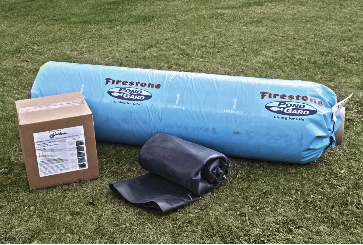Advantages of Firestone PondGard EPDM rubber pond liner
Some of most used pond liner materials worldwide are EPDM, HDPE, and PVC. EPDM stands for Ethylene Propylene Diene Monomer, a complex yet relatively inexpensive synthetic rubber is used in a wide range of applications commonly in the automotive and construction industries. Due to its excellent resistance to environmental factors such as Ozone, UV and general weathering, EPDM is one of the most common materials used for seals and O-rings. HDPE stands for High Density Polyethylene and PVC stands for Poly Vinyl Chloride are thermoplastic polymers based on petroleum.
Advantages of Firestone PondGard EPDM rubber pond liner or EPDM rubber geomembrane compared to HDPE or PVC liners:
- - Fish friendly – EPDM rubber liners do not pose any risk to fish, plants or other aquatic life (tested & certified) while PVC is not suitable for Aquatic life as it contains Plasticizers.
- - EPDM can sustain very low temperature as low as minus 45degC, while PVC doesn’t function well at very high and very low temperatures. Hence it is ideal for an indoor pool, or one located in a shady area.
- - High flexibility of the EPDM offers DIY installation. EPDM liners fold around corners very easily. So, you can now get your hands dirty and build your pond just the way you want it. HDPE liners on the other hand are although relatively flexible, it is not as flexible as EPDM. So careful preparation will be needed prior to installation.
- - EPDM rubber lines can be patched and repaired, if need be, using Quick prime, Liner Seam joining tapes, Cover strips, EPDM Liner Puncture repair kit and related accessories (… also available at Rock Around The Block). Unlike EPDM liners, HDPE joining requires heat (welding) and hence will require professional assistance.
- - Studies have proven high UV resistance of EPDM rubber geomembrane lining products and very few flexible membranes can match this characteristic.
- - 20-year warranty period assures peace of mind. In our many years of selling EPDM pond and dam liner, we have never had a warranty claim. Firestone's first liner project that was completed in 1973 is still going strong, a 12,000 sqm dam in hot Southern Spain. Hence, we can say that it is virtually maintenance free.
- - Please refer to our Technical Information and Instructional Videos sub-categories for more details.
After studying various available options for pond liners in Australian market, we however believe that Firestone PondGard EPDM 1.02mm rubber pond liner is the most popular liner choice for both hobbyist and commercial installers. Please contact our team on 1300 733 113 or email us at sales@ratb.com.au for a free PondGard EPDM sample to be sent in an envelope.
At Rock Around The Block, we retail EPDM pond rubber liners in various prefixed widths – 3.05m, 4.88m, 6.10m, 7.62m, 9.15m, 12.20m & 15.25m. The length of the liner will be cut to your required length, which presents the benefit of tailoring your pond liner suitable to your pond’s size and hence avoiding wastage.
We also highly recommend investing in an underlay for your pond. Geotextile underlay is placed underneath your pond liner to prevent punctures from rough or rocky ground (e.g., those with volcanic stones). In addition to offering puncture resistance, underlay also allows the gases beneath your pond to escape, rather than becoming trapped and causing gas bubbles underneath your pond liner. An Underlay is also handy for when you are looking to install larger rocks in your pond, placed in between the pond liner and the rock for additional protection.
Troubleshooting: LINER FLOATING UP:
There are three reasons for this possible occurrence:
- - Rising water table: Liner may rise to the surface in bulges if the surrounding water table rises during a prolonged wet period. If your pond or dam is built in a depression, a hydrostatic valve must be installed and sealed correctly through the liner into a gravel pit below the liner at the lowest point of the pond. This will allow a balance of the ground water pressure by under-liner water escaping through the one-way valve into the pond water.
- - Potential of rising water table from a spring: If there is a known spring and the pond or dam is higher than the surrounding land then a network of slotted drainpipes must be fitted into the profile under the liner to allow this continuous water under the liner to waste away. A good example for this is if you dam a ravine or gully. A waste pipe should be placed through the base of the wall to allow under-liner water to escape.
- - Gas below the liner: If liner is to be placed over buried vegetation, in time, gas will escape causing bulging. It is essential to vent under the liner.
For correct preparation, refer to Installation Guidelines in the Technical Information.
Recommendations:
- - Bamboo: It is advisable not to use any liner membrane systems adjacent to bamboo vegetation because of potential penetration by its sharp pointy rhizome shoots. If to be the case, to reduce the potential problem an impenetrable continuous vertical in-ground barrier to well below the root ball made of hard plastic or reinforced concrete must be installed between the bamboo & the pond wall.
- - Rapid set concrete: Do not use Rapid Set Concrete to prepare the base or substrate. The hexavalent chromium compounds in the concrete, will cause most liner geomembranes to crumble & crack - see Chemical Resistance Chart in the Technical Information category for more details.
- Why buy from us? We offer the full suite of Firestone accessories system. We are trained in usage of Firestone products and have been retailing & assisting our customers with EPDM rubber pond linings for over 25 years.
>> EXPLORE FIRESTONE POND LINER RANGE







